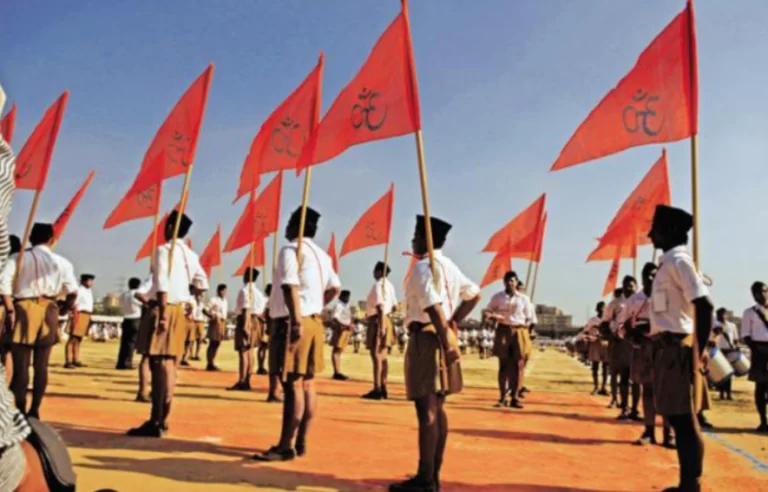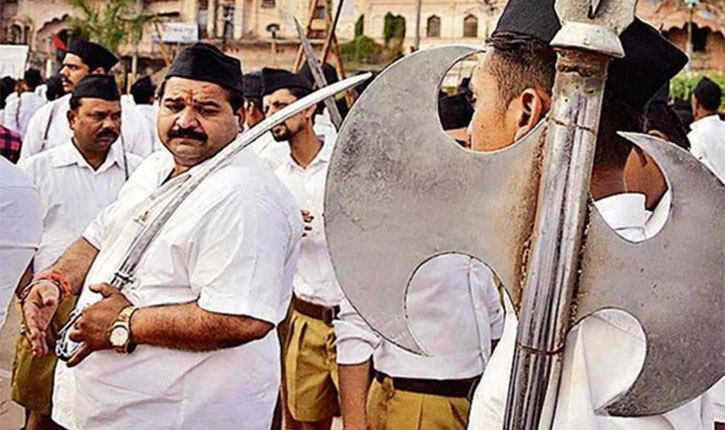
It is well known that the then Communist Party of India opposed the Quit India Movement, thus betraying a great phase of mass upsurge in the history of the freedom struggle. However, the role Hindu Mahasabha and Rashtriya Swayamsevak Sangh played in the movement remains under wraps for reasons unknown.
Shamsul Islam
The Quit India Movement, also known as ‘August Kranti’, was a nationwide civil disobedience movement for which a call was given on August 7, 1942 by the Bombay session of the All India Congress Committee. It began on August 8, with Gandhi giving the ‘Do or Die’ call in his ‘Quit India’ speech delivered in Mumbai at the Gowalia Tank Maidan.
The British swiftly responded with mass detentions. Over 100,000 arrests were made, mass fines were levied and demonstrators were subjected to public flogging. Hundreds of civilians were killed, many shot and injured by the police and the army. Many national leaders went underground and continued their struggle by broadcasting messages over clandestine radio stations, distributing pamphlets and establishing parallel governments.
It is well known that the then Communist Party of India opposed the Quit India Movement, thus betraying a great phase of mass upsurge in the history of the freedom struggle. However, the role Hindu Mahasabha and Rashtriya Swayamsevak Sangh played in the movement remains under wraps for reasons unknown.
The Hindutva camp not only opposed the movement but also supported British rulers in suppressing this historic mass upsurge.
Addressing the 24th session of the Hindu Mahasabha at Cawnpore (now Kanpur) in 1942, ‘Veer’ Savarkar outlined the strategy of the Hindu Mahasabha of cooperating with the rulers in the following words:
“The Hindu Mahasabha holds that the leading principle of all practical politics is the policy of Responsive Co-operation…The policy of responsive co-operation which covers the whole gamut of patriotic activities from unconditional co-operation right up to active and even armed resistance, will also keep adapting itself to the exigencies of the time, resources at our disposal and dictates of our national interest.”
This ‘Responsive Cooperation’ with the British masters was not only a theoretical commitment. It soon got concretised in the ganging up of Hindu Mahasabha with the Muslim League. The Hindu Mahasabha, led by Savarkar, ran coalition governments with the Muslim League in 1942. Savarkar defended this nexus in his presidential speech to the 24th session of Hindu Mahasabha at Kanpur in 1942 in the following words: “In practical politics also the Mahasabha knows that we must advance through reasonable compromises. Witness the fact that only recently in Sind, the Sind-Hindu-Sabha on invitation had taken the responsibility of joining hands with the League itself in running coalition Government. The case of Bengal is well known. Wild Leaguers whom even the Congress with all its submissive-ness could not placate grew quite reasonably compromising and socialable as soon as they came in contact with the HM and the Coalition Government, under the premiership of Mr Fazlul Huq and the able lead of our esteemed Mahasabha leader Dr Syama Prasad Mookerji, functioned successfully for a year or so to the benefit of both the communities.”
Hindu Mahasabha and Muslim League, beside Bengal and Sindh, ran the coalition government in NWFP too during this period.

Syama Prasad Mookerjee took the responsibility of crushing Quit India Movement
Following the Hindu Mahasabha directive to co-operate with the British, Hindutva icon Dr. Mookerjee assured the British rulers in a letter dated July 26, 1942:
“Let me now refer to the situation that may be created in the province as a result of any widespread movement launched by the Congress. Anybody, who during the war, plans to stir up mass feeling, resulting internal disturbances or insecurity, must be resisted by any Government that may function for the time being”
The second-in-command of the Hindu Mahasabha, Dr Syama Prasad Mookerjee, who was also the Deputy Chief Minister in the Muslim league-led ministry in Bengal made it clear that both these parties looked at the British rulers as saviors of Bengal against the Quit India Movement launched by Congress.
In this letter, he mentioned item wise the steps to be taken for dealing with the situation. It read: “The question is how to combat this movement (Quit India) in Bengal? The administration of the province should be carried on in such a manner that in spite of the best efforts of the Congress, this movement will fail to take root in the province. It should be possible for us, especially responsible Ministers, to be able to tell the public that the freedom for which the Congress has started the movement, already belongs to the representatives of the people. …Indians have to trust the British, not for the sake of Britain, not for any advantage that the British might gain, but for the maintenance of the defence and freedom of the province itself.”
RSS followed Savarkar in opposing Quit India Movement
The other flag-bearer of Hindutva, the RSS, was no different in its attitude towards the Quit India Movement. It openly sided with its mentor ‘Veer’ Savarkar against this great revolt. The RSS’ attitude towards the movement becomes clear from the following utterances of its second chief and most prominent ideologue till date, MS Golwalkar. While talking about the outcome of the Non-Cooperation Movement and the Quit India Movement, he said:
“Definitely there are bound to be bad results of struggle. The boys became unruly after the 1920-21 movement. It is not an attempt to throw mud at the leaders. But these are inevitable products after the struggle. The matter is that we could not properly control these results. After 1942, people often started thinking that there was no need to think of the law.”
Thus, the prophet of Hindutva, Golwalkar, wanted the Indians to respect the draconian and repressive laws of the inhuman British rulers! He admitted that this kind of negative attitude towards the Quit India Movement did not go down well even with the RSS cadres:
“In 1942 also there was a strong sentiment in the hearts of many. At that time, too the routine work of Sangh continued. Sangh vowed not to do anything directly. However, upheaval (uthal-puthal) in the minds of Sangh volunteers continued. Sangh is an organisation of inactive persons, their talks are useless, not only outsiders but also many of our volunteers did talk like this. They were greatly disgusted too.”
It would be interesting to note what Golwalkar meant by ‘routine work of Sangh’. It surely meant working overtime to widen the divide between Hindus and Muslims, thus serving the strategic goal of the British rulers and Muslim League.
In fact, contemporary reports of the British intelligence agencies on the Quit India Movement were straight forward in describing the fact that RSS kept away from the Quit India Movement. According to one such report, “The Sangh has scrupulously kept itself within the law, and in particular, has refrained from taking part in the disturbances that broke out in August 1942”.
These historically documented facts make it clear that the RSS not only betrayed the Quit India Movement but also rendered great service to the British masters by aligning with the Muslim League when the former were faced with the nation-wide popular revolt by the Indians. They together mounted one of the fiercest repressions on the freedom fighters. Shockingly, they now rule over India and call RSS the symbol of Indian nationalism.
———————————–
The author is former Professor, Delhi University; his writing can be accessed at http://du-in.academia.edu/ShamsulIslam
Courtesy: National Herald